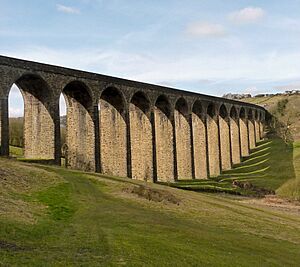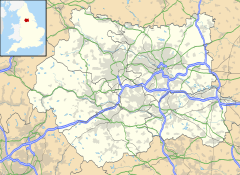Thornton, West Yorkshire facts for kids
Quick facts for kids Thornton |
|
|---|---|
 Thornton Viaduct |
|
| Population | 17,276 (Thornton and Allerton ward. 2011 census) |
| OS grid reference | SE098326 |
| Metropolitan borough | |
| Metropolitan county | |
| Region | |
| Country | England |
| Sovereign state | United Kingdom |
| Post town | BRADFORD |
| Postcode district | BD13 |
| Dialling code | 01274 |
| Police | West Yorkshire |
| Fire | West Yorkshire |
| Ambulance | Yorkshire |
| EU Parliament | Yorkshire and the Humber |
| UK Parliament |
|
Thornton is a village in West Yorkshire, England. It's part of the City of Bradford. The village is about 6 miles (10 km) west of Bradford's city centre.
In 2011, Thornton and its neighbour Allerton had over 17,000 residents. By 2021, this number grew to over 18,500 people. Thornton is most famous for being the birthplace of the Brontë sisters.
The middle of the village still looks like a traditional Pennine village. It has old stone houses with stone roofs. Newer houses are mostly on the edges of the village. Green fields still separate Thornton from the rest of Bradford.
Contents
Thornton's History and Location
The name Thornton comes from old English words. It means a farm or settlement near a thorn tree. The village was first mentioned in the Domesday Book in the 11th century. At that time, it had been damaged by William the Conqueror. This was punishment for a rebellion against the Normans.
Thornton used to be a small area within the larger Bradford parish. In 1866, it became its own civil parish. A local board managed the area starting in 1865. These local boards later became urban district councils.
Thornton Urban District was short-lived, lasting less than five years. In 1899, it became part of the city of Bradford. The civil parish of Thornton continued until 1974. However, it was directly managed by the city council. In 1951, the parish had a population of 6,097 people.
In 1974, the larger City of Bradford was created. Thornton then became an area without its own parish council. Today, Thornton is part of the Thornton and Allerton ward. It is also part of the Bradford West area for Parliament.
How Thornton Grew
Thornton is high up and has poor soil. It also gets nearly 1,000 mm of rain each year. This made farming difficult. But things changed with new resources like coal, iron, and sandstone. New roads and railways also helped.
These changes allowed Thornton to share in the wealth of the 19th-century wool trade. Factories using steam power became more common. This meant less work was done in homes. Manufacturing then moved to the valleys in the city centre.
Later, foreign imports and the Second World War caused manufacturing to decline. The railways also closed. Today, Thornton is mainly a place where people live and commute to Bradford.
The main road through the village was Market Street. But in 1826, a new road called Thornton Road (B6145) was built. Most new buildings since then have been along Thornton Road. This has made the village spread down the hill.
Market Street has stayed mostly the same. It still has its original look and stone buildings. Market Street is now a special conservation area. Thornton Road is still the main route for traffic. It connects to Bradford, Allerton, Halifax, Keighley, and Denholme.
Famous People from Thornton
Thornton's most famous residents were the Brontës. Their father, Reverend Patrick Brontë, became the minister of Thornton Chapel in 1815. Charlotte, Branwell, Emily, and Anne Brontë were all born at 74 Market Street in Thornton. The family later moved to Haworth.
In November 2023, a group bought the house where the Brontës were born. They plan to restore and protect it as the Brontë Birthplace. You can still see the remains of the church where their father preached. It's called the Bell Chapel and is in the old graveyard near Thornton Road.
The Brontë Way is a 44-mile (71 km) walking path. It goes through Thornton on its way between Gawthorpe Hall and Oakwell Hall.
Another famous resident was professional wrestler Les Kellett. He owned a small farm and a café called "The Terminus." This was where trolleybuses would stop before going back to Bradford. Les Kellett sometimes raised pigs and once said he kept 50 cattle on his 2-acre (0.8 ha) property.
Thornton Viaduct
The Thornton Viaduct was a railway bridge. It was part of the Great Northern Railway line. This line ran from Queensbury to Keighley through Thornton. The viaduct was built in an S-shape. This allowed trains to smoothly reach Thornton railway station.
Today, the viaduct is a Grade II listed building. This means it's an important historic structure.
The viaduct was reopened in 2009. It is now part of The Great Northern Railway Trail. This trail is a walking and cycling path. It connects Cullingworth and Queensbury. The final link to Queensbury opened in 2012.
See also
 In Spanish: Thornton (Yorkshire del Oeste) para niños
In Spanish: Thornton (Yorkshire del Oeste) para niños



